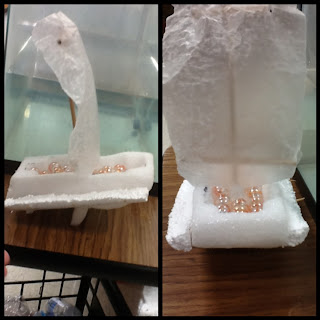MarineMaster
Sunday, December 2, 2012
Plankton Racing
My plank tone was two post it notes together. This allowed a large surface area to make my plankton to sink slowly. The only worry was that the paper was not to turn and had to be pushed in evenly. The plankton's sinking time was taken for a distance of 35.5 centimeters. My average time was 18.3 seconds, which revealed a speed of 1.94 centimeters per second. Other supplies were tested but I bent and tore so may supplies that they became useless and would not sink slowly so I just kept it simple to use paper. The most interesting thing about this project was how to make everything try and work by adding and reducing weight and trying to make spikes like real plankton use.
Sunday, November 18, 2012
Plankton Race ABSENT
Plankton of the Sea
The two main types of planklton are the phytoplankton and the zooplankton. Both of these plankton are vital members to the oceanic ecosystem as they are the base of the food web for the majority of marine life. One issue in which plankton face is sinking. These drifters need to stay with the current at the surface of the water. Therefore, without the plankton, there is no food or nutrients for the other organisms. The most interesting thing about plankton that I learned was that there are multiple types of zooplankton. This proves to me that I underestimated the necessity and importance of plankton by the manipulization of the TV series "Spongebob".
Freeday Yeti Lobster
The Yeti Lobster was discovered in 2005 in the South Pacific Ocean. It is thought to be blind and it has fur-like hairs on it's limbs. These limbs help detoxify the poisonous water in whihc it inhabits. The Yeti Lobster is interesting to me because it seems to unique to be real, therefore since it was discovered in 2005, this shows that there could be more wonders which have yet to be discovered.
Saltwater Crocodile
The saltwater crocodile can adapt to both saltwater adn freshwater as it inhabits freshwater rivers in the tropical wet seasons but can venture out far into the ocean if needed. During the wet seasons, the crocodiles find mates and defend the nest for their eggs until they hatch. The mother will stay with the young for several months after hatching to help teach them to hunt and adapt. Saltwater crocodiles are the largest reptiles today and they are extremely territorial, so they often attack humans because they see them as prey in their territory. The saltwater crocodile is endangered, but it is at lower risk of extinction. In order to protect these monsterous miracles, poaching can be prevented and wildlife reserves can be an effort to help these animals peacefully reproduce.
Boat Racing
I chose the design with two floats on the sides of the boat in order to keep balance. I used heavy styrofoam in order to be able to float while easily holding twenty marbels and the wax paper sail helped catch the wind better. The keel and rudder helped keep balance and I felt it helped that they were physically inseperable form the boat. The wooden sticks used to hold the sail were lightweight in order to help move faster and also stay sturdy enough to catch the wind. This worked for our project, but it was not the fastest. If i did this over, I would find lighter materials to make the boat sail faster so it wasn't so sluggish. The most interesting part of the project was the excitement and suspense of seeing if the boat worked or not.
Friday, November 9, 2012
Plankton Red Tides
Phytoplankton are a microorganism that are able to produce an algal bloom called the Red Tide. Red Tides rapidly grow in water, which are algal blooms that display a red or brown color. This problem is caused by unclean water, which directly affects its ecosystem. Red Tides can cause oxygen depletion in the water and can harm animals that depend on that certain water system for nutrients.
Subscribe to:
Comments (Atom)





